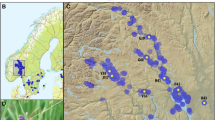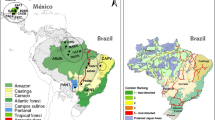Abstract
Recent anthropogenic habitat perturbationsrelated to the unsustainable development of thetwo areas of distribution of Androcymbiumgramineum in Almería (South of Spain) andthe Atlantic coast of Morocco are outweighingthe intrinsic biological survival assets ofthis narrow Ibero-Moroccan endemic. We usedpopulation genetic data on 18 isozyme loci for13 populations to design a comprehensivesampling strategy for ex-situ conservation thatstraddles the results of independenttheoretical developments and the indications ofseveral genetic polymorphism parameters.Regressions based on the probabilities of lossestimate that sampling one population would beinsufficient to represent the variationattributable to the rare alleles found in thepopulations surveyed from Almería orMorocco and suggest that the relationshipbetween the number of populations sampled ineither area should conform to the proportion0.6:0.4, respectively. The estimate of thenumber of populations that need be targeted torepresent 99% of the genetic variationdetected indicates that it would be necessaryto sample eight populations intensively. Fivepopulations from Almería and three fromMorocco were selected through the ranked valuesof the average number of alleles per locus andthe expected heterozygosity on the grounds thatthese parameters provide unambiguousindications of polymorphism that, in the caseof heterozygosity, are less likely to beinfluenced by sampling error. Spatialautocorrelation surveys in the largestpopulation known indicate that seeds should becollected at a minimum separation of 15 m toavoid the sampling of close relatives.
Similar content being viewed by others
References
Ardanuy A (1997) Estudis basics per la Gestió Agronòmica i la conservació de sis espècies del gènere Androcymbium Willd. MSc Thesis, Universitat de Girona.
Batista F, Bañares A, Caujapé-Castells J, Marrero-Gómez M, Carqué E, Sosa PA (2001) Allozyme diversity in three endemic species of Cistus (Cistaceae) from the Canary islands: Intraspecific and interspecific comparisons and implications for genetic conservation. American Journal of Botany, 88, 1582–1592.
Bengtsson BO, Weibull P, Ghatnekar L (1995) The loss of alleles by sampling: A study of the common outbreeding grass Festuca ovina over three geographical scales. Hereditas, 122, 221–238.
Boletín Oficial de la Junta de Andalucía (1994) No. 107, Decreto 104/94.
Britten HB (1996) Meta-analyses of the association between multilocus heterozygosity and fitness. Evolution, 50, 2158–2164.
Brussard PF (1991) The role of ecology in biological conservation. Ecological Applications, 1, 6–12.
Caujapé-Castells J (2001) Transformer 1.0: Un programa de formateado de datos genotípicos individuales para implementación en programas de análisis molecular en genética de poblaciones. Distributed by the author.
Caujapé-Castells J (2002) La diversidad genética a las duras y a las maduras: Oa relación entre Androcymbium gramineum y las catástrofes naturales. Proceedings of the 1st Congreso de Biología de Conservación de Plantas. Universidad de València, Jardí Botànic de València, pp. 18.
Caujapé-Castells J, Pedrola-Monfort J (1997) Space-time patterns of genetic structure within a stand of Androcymbium gramineum (Cav.) McBride (Colchicaceae). Heredity, 79,341–349.
Caujapé-Castells J, Jansen RK, Membrives N, Pedrola-Monfort J, Montserrat JM, Ardanuy A (2001) Historical biogeography of Androcymbium Willd. (Colchicaceae): Evidence from cpDNA RFLPs. Botanical Journal of the Linnean Society, 136, 379–392.
Caujapé-Castells, División de Sistemas de Información ITC (2003) Transformer 2.0. Beta version 1.
Caujapé-Castells J, Jansen RK (2003) The influence of the Miocene Mediterranean desiccation on the geographical expansion and genetic variation of Androcymbium gramineum (Cav.) McBride (Colchicaceae). Molecular Ecology (in press).
Ceska JF, Affolter JM, Hamrick JL (1997) Developing a sampling strategy for Baptisia arachnifera based on allozyme diversity. Conservation Biology, 11, 1133–1133.
Chamberlain JR (1998) Isozyme variation in Calliandra calothyrsus (Leguminosae): Its implications for species delimitation and conservation. American Journal of Botany, 85, 37–47.
Chung MY, Epperson BK, Chung MG (2003) Genetic structure of age classes in Camellia japonica (Theaceae) Evolution, 57, 62–73.
Culley TM, Wallace LE, Gengler-Nowak KM, Crawford DJ (2002) A comparison of two methods of calculating GST, a genetic measure of population differentiation. American Journal of Botany, 89, 460–465.
David P (1998) Heterozygosity-fitness correlations: New perspectives on old problems. Heredity, 80, 531–537.
Elliott AC, Pierce A (1992) Size, growth rate, and multiplelocus heterozygosity in the land snail (Otala lactea). Journal of Heredity, 83, 270–274.
Francisco-Ortega J, Santos-Guerra A, Kim SC, Crawford DJ (2000) Plant genetic diversity in the Canary Islands: A conservation perspective. American Journal of Botany 87, 909–919.
Frankel OH, Brown AHD, Burdon JJ (1995) The Conservation of Plant Biodiversity. Cambridge University Press, Cambridge.
Hamrick JL (1983) The distribution of genetic variation within and among natural plant populations. In: Genetics and Conservation: A Reference for Managing Wild Animal and Plant Populations (eds. Schonewald-Cox CM, Chambers SM, MacBride B, Thomas WL), pp. 335–348. Benjamin/Cummings, Menlo Park, CA.
Hamrick JL, Godt MJW (1989) Allozyme diversity in plant species. In: Plant Population Genetics, Breeding and Genetic Resources (eds. Brown AHD, Clegg MT, Kahler AL, Weir BS), pp. 43–63. Sinauer, Sunderland, Massachusetts.
Hamrick JL, Godt MJW, Murawski DA, Loveless MD (1991) Correlations between species traits and allozyme diversity: Implications for conservation biology. In: Genetics and Conservation of Rare Plants (eds. Falk DA, Holsinger K), pp. 75–86. Oxford University Press, New York.
Hernández-Bermejo JE, Clemente-Muñoz M (eds.) (1993) Protección de la Flora de Andalucía. Junta de Andalucía.
Lande R (1988) Genetics and demography in biological conservation. Science, 241, 1455–1460.
Lewis PO (1993) GeneStat-PC 3.31. North Carolina State University, Raleigh, North Carolina.
Martínez-Palacios A, Eguiarte LE, and Furnier GR (1999) Genetic diversity of the endangered endemic Agave victoriae-reginae (Agavaceae) in the Chihuahuan Desert. American Journal of Botany, 86, 1093–1098.
Médail F, Quézel P (1997) Hot-spots analysis for conservation of plant biodiversity in the Mediterranean basin. Annals of the Missouri Botanical Garden, 84, 112–128.
Mitton JB, Grant MC (1984) Associations among protein heterozygosity, growth rate, and developmental homeostasis. Annual Review of Ecology and Systematics, 15, 479–499.
Nei M (1973) Analysis of gene diversity in subdivided populations. Proceedings of the National Academy of Sciences of the USA, 70, 3321–3323.
Richter TS, Soltis PS, Soltis DE (1994) Genetic variation within and among populations of the narrow endemic, Delphinium viridescens (Ranunculaceae). American Journal of Botany, 81, 1070–1076.
Savolainen O, Hedrick P (1995) Heterozygosity and fitness: No association in Scots Pine. Genetics, 140, 755–766.
Schemske DW, Husband BC, Ruckelshaus MH, Goodwillie C, Parker IM, Bishop JM (1994) Evaluating approaches to the conservation of rare and endangered plants. Ecology, 75, 584–606.
Schonewald-Cox CM, Chambers SM, MacBride B, Thomas WL, editors (1983) Genetics and Conservation: A Reference for Managing Wild Animal and Plant Populations, Benjamin Cummings, Menlo Park, CA.
Sokal RR (1979) Testing statistical significance of geographical variation patterns. Systematic Zoology, 8, 227–232.
Soltis DE, Gitzendanner MA, Strenge DD, Soltis PS (1997) Chloroplast DNA intraspecific phylogeography of plants from the Pacific Northwest of North America. Plant Systematics and Evolution, 206, 353–373.
Soltis PS, Gitzendanner MA (1999) Molecular systematics and the conservation of rare species. Conservation Biology, 13, 471–483.
Swofford DL, Selander RB (1988) BIOSYS-1: A Computer Program for the Analysis of Allelic Variation in Genetics. University of Illinois, Urbana, IL.
Templeton A, Shaw K, Routman E, Davis SK (1990). The genetic consequences of habitat fragmentation. Annals of the Missouri Botanical Garden, 77, 13–27.
Vilches B, Roca A, Naranjo J, Navarro B, Bramwell D, Caujapé Castells J (2002) La variación genética de Erysimum L. (Brassicaceae) en Gran Canaria. Proceedings of the 1st Congreso de Biología de Conservación de Plantas. Universidad de València, Jardí Botànic de València, pp. 39.
V.V.A.A. (2000) Lista Roja de Flora Vascular Española (valoración según categorías UICN). Conservación Vegetal, 6, 11–38.
Wright S (1922) Coefficients of inbreeding and relationship. American Naturalist, 56, 330–338.
Zouros E, Foltz DW (1987) The use of allelic isozyme variation for the study of heterosis. Isozymes, 13, 1–59.
Author information
Authors and Affiliations
Corresponding author
Rights and permissions
About this article
Cite this article
Caujapé-Castells, J., Pedrola-Monfort, J. Designing ex-situ conservation strategies through the assessment of neutral genetic markers: Application to the endangered Androcymbium gramineum . Conservation Genetics 5, 131–144 (2004). https://doi.org/10.1023/B:COGE.0000029997.59502.88
Issue Date:
DOI: https://doi.org/10.1023/B:COGE.0000029997.59502.88




